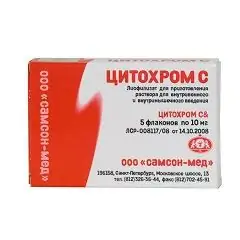- Author Rachel Wainwright [email protected].
- Public 2023-12-15 07:39.
- Last modified 2025-11-02 20:14.
Cytochrome C
Latin name: Cytochrom C
ATX code: C01CX
Active ingredient: cytochrome C (cytochrome C)
Manufacturer: Samson-Med (Russia)
Description and photo update: 2018-25-10

Cytochrome C is a metabolic agent.
Release form and composition
- eye drops 0.25% (2 ml in vials with a dropper cap, 1 vial in a cardboard box);
- solution for intravenous (i / v) and intramuscular (i / m) administration (4 ml in vials; 5 or 10 vials in a cardboard box, or 5 vials in plastic contour packages, 1-2 packages in a cardboard box);
- lyophilisate for preparation of a solution for i / v and i / m administration (10 mg in vials; 5 vials in a cardboard box, or 5 vials in a blister strip, 1-2 packages in a cardboard box).
The active substance is cytochrome C:
- 1 ml of eye drops - 2.5 mg;
- 1 ml of solution for intravenous and intramuscular administration - 2.5 mg;
- 1 bottle of lyophilisate - 10 mg.
Pharmacological properties
Pharmacodynamics
Cytochrome C is a metabolic drug that has antihypoxic and trophic effects, stimulates regeneration processes, and is a catalyst for cellular respiration.
The active ingredient of the drug: cytochrome C is a small heme-containing protein belonging to the class of cytochromes, in the prosthetic group of the molecule of which there is iron, which can pass from an oxidized state to a reduced state. As a result, metabolic processes and redox reactions in tissues are accelerated, oxygen utilization improves, tissue hypoxia decreases in various pathological conditions, on which the mechanism of action of the drug is based.
Pharmacokinetics
Cytochrome C is rapidly and completely absorbed, penetrates well into the cells of tissues and organs.
Indications for use
Solution for i / v and i / m administration (including prepared from lyophilisate)
According to the instructions, Cytochrome-C is used as an agent that improves tissue respiration, as part of the complex therapy of conditions accompanied by a violation of redox processes in the body:
- asphyxia of newborns;
- chronic obstructive pulmonary disease;
- bronchial asthma with respiratory failure during the period of remission;
- heart failure;
- poisoning with hypnotics and carbon monoxide;
- viral hepatitis, complicated by hepatic coma;
- severe injuries;
- the period before and after surgery (to prevent shock).
Eye drops
- opacity of the cornea;
- primary and secondary corneal dystrophy;
- keratitis (at the stage of epithelialization).
Contraindications
- pregnancy;
- lactation period;
- hypersensitivity to the drug.
Cytochrome C eye drops, in addition, are contraindicated in children and adolescents under the age of 18.
Instructions for the use of Cytochrome C: method and dosage
Solution for i / v and i / m administration (including prepared from lyophilisate)
Cytochrome C is injected slowly intravenously and intramuscularly. The lyophilisate is dissolved in 4 ml of injection water immediately before administration.
Also, before the first injection, it is recommended to determine the patient's individual sensitivity to the drug. For this, 0.1 ml of solution (0.25 mg) is injected intradermally. If there are no negative reactions (itching of the skin, urticaria, redness of the face) within 30 minutes, then therapy can be started. Before the repeated course, a biological test is necessarily shown.
The recommended dose is 10-20 mg 1-2 times a day for 10-14 days.
In heart failure, the lyophilisate is diluted in 200 ml of isotonic sodium chloride solution or 5% glucose solution. Introduce intravenously drip over 6-8 hours at a rate of 30-40 drops per minute. The average daily dose can vary from 30 to 80 mg.
In the postoperative period after surgery for congenital or acquired heart defects, Cytochrome C is administered intravenously at 10 mg 2 times a day.
In severe conditions (hepatic coma, shock, trauma, poisoning with carbon monoxide or hypnotics), the dose of Cytochrome C is 50-100 mg and is injected intravenously.
In case of asphyxiation in newborns, a solution at a dose of 10 mg is injected into the umbilical vein within the first two minutes after birth.
For patients with bronchial asthma, the drug is administered intramuscularly at 5-10 mg 2 times a day. The duration of treatment is 14-25 days, depending on the severity of hypoxia.
Eye drops
Cytochrome C in this dosage form is instilled 1-2 drops into the conjunctival sac of the affected eye 3 or 4 times a day.
Side effects
The rapid introduction of the solution can contribute to the occurrence of chills, an increase in body temperature, and the development of allergic reactions.
With prolonged intravenous and intramuscular use of Cytochrome C, it is possible to change the indicators of the blood coagulation system, the picture of peripheral blood and liver function.
Cytochrome C eye drops can cause short-term burning sensation, conjunctival hyperemia, and allergic reactions.
Overdose
No information available.
special instructions
Influence on the ability to drive vehicles and complex mechanisms
The drug does not affect a person's ability to drive vehicles and perform potentially hazardous activities that require speed of reactions and increased attention.
Application during pregnancy and lactation
Cytochrome C in both dosage forms is contraindicated during pregnancy and lactation.
Pediatric use
There are no age restrictions for the use of a solution for injection (including one prepared from a lyophilisate).
Cytochrome C eye drops are contraindicated for use in patients under the age of 18.
Drug interactions
No information available.
Analogs
An analogue of Cytochrome C eye drops is Oftan Katakhrom.
Terms and conditions of storage
Store in a dark, dry place out of the reach of children at a temperature of 4-20 ° C.
The shelf life for all forms of release is 2 years. After the first opening of the bottle, eye drops can be stored for no more than 3 days in the refrigerator in a closed form.
Terms of dispensing from pharmacies
Solution for intravenous and intramuscular administration and lyophilisate for solution preparation are dispensed with a prescription, eye drops - without a prescription.
Reviews of Cytochrome C
This drug is used as part of the complex therapy of hypoxic conditions and for their prevention, therefore, it is not possible to assess the degree of its effectiveness. Nevertheless, on specialized medical forums, there are positive reviews about Cytochrome C, most often they are left by women whose newborn children were injected with the drug due to asphyxia.
In addition, the effectiveness of Cytochrome C has been confirmed by experimental and clinical studies. For example, the drug was included in intensive care in the postoperative period for patients who had undergone heart valve replacement surgery. It was administered at a dose of 500 mg / kg before and immediately after surgery. As a result, the anti-ischemic and antihypoxic properties of the drug were confirmed. It improves the work of the heart muscle in ischemic conditions, contractile function and coronary blood flow. Cytochrome C has been confirmed to be effective as a cardioprotector in open heart surgeons.
The properties of the drug were studied when used in the acute period of myocardial infarction.
Good results were achieved with its intravenous (even single) dose of 50-100 mg in case of carbon monoxide poisoning.
The antioxidant activity of Cytochrome C is used in the complex treatment of diabetic neuropathy, as well as for the normalization of gas exchange in the mother-placenta-fetus system in fetoplacental insufficiency.
Price for Cytochrome C in pharmacies
The price for Cytochrome C in the form of a lyophilisate is 1285-1500 rubles. for a package of 5 bottles; the cost of eye drops is on average 225 rubles. for 1 bottle. The price of the solution for i / v and i / m administration is currently unknown.

Maria Kulkes Medical journalist About the author
Education: First Moscow State Medical University named after I. M. Sechenov, specialty "General Medicine".
Information about the drug is generalized, provided for informational purposes only and does not replace the official instructions. Self-medication is hazardous to health!






